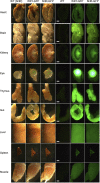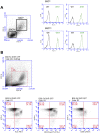New Wistar Kyoto and spontaneously hypertensive rat transgenic models with ubiquitous expression of green fluorescent protein
- PMID: 26769799
- PMCID: PMC4852507
- DOI: 10.1242/dmm.024208
New Wistar Kyoto and spontaneously hypertensive rat transgenic models with ubiquitous expression of green fluorescent protein
Abstract
The Wistar Kyoto (WKY) rat and the spontaneously hypertensive (SHR) rat inbred strains are well-established models for human crescentic glomerulonephritis (CRGN) and metabolic syndrome, respectively. Novel transgenic (Tg) strains add research opportunities and increase scientific value to well-established rat models. We have created two novel Tg strains using Sleeping Beauty transposon germline transgenesis, ubiquitously expressing green fluorescent protein (GFP) under the rat elongation factor 1 alpha (EF1a) promoter on the WKY and SHR genetic backgrounds. The Sleeping Beauty system functioned with high transgenesis efficiency; 75% of new rats born after embryo microinjections were transgene positive. By ligation-mediated PCR, we located the genome integration sites, confirming no exonic disruption and defining a single or low copy number of the transgenes in the new WKY-GFP and SHR-GFP Tg lines. We report GFP-bright expression in embryos, tissues and organs in both lines and show preliminaryin vitroandin vivoimaging data that demonstrate the utility of the new GFP-expressing lines for adoptive transfer, transplantation and fate mapping studies of CRGN, metabolic syndrome and other traits for which these strains have been extensively studied over the past four decades.
Keywords: GFP; Rat; SHR; Transgenics; WKY.
© 2016. Published by The Company of Biologists Ltd.
Conflict of interest statement
The authors declare no competing or financial interests.
Figures





Similar articles
-
Stable long-term germline transmission of GFP transgenic rat via PiggyBac transposon mediated gene transfer.BMC Vet Res. 2024 Jun 26;20(1):275. doi: 10.1186/s12917-024-04123-7. BMC Vet Res. 2024. PMID: 38918814 Free PMC article.
-
Generation of trangenic Xenopus laevis using the Sleeping Beauty transposon system.Transgenic Res. 2006 Dec;15(6):751-60. doi: 10.1007/s11248-006-9014-6. Epub 2006 Sep 7. Transgenic Res. 2006. PMID: 16957880
-
Strain differences in superovulatory response, embryo development and efficiency of transgenic rat production.Transgenic Res. 2005 Oct;14(5):729-38. doi: 10.1007/s11248-005-7218-9. Transgenic Res. 2005. PMID: 16245164
-
Genealogy of the spontaneously hypertensive rat and Wistar-Kyoto rat strains: implications for studies of inherited hypertension.J Cardiovasc Pharmacol. 1990;16 Suppl 7:S1-5. J Cardiovasc Pharmacol. 1990. PMID: 1708002 Review.
-
Recent advances in genetics of the spontaneously hypertensive rat.Curr Hypertens Rep. 2010 Feb;12(1):5-9. doi: 10.1007/s11906-009-0083-9. Curr Hypertens Rep. 2010. PMID: 20425152 Free PMC article. Review.
Cited by
-
Delivery of Mesenchymal Stem Cells during Hypothermic Machine Perfusion in a Translational Kidney Perfusion Study.Int J Mol Sci. 2024 May 5;25(9):5038. doi: 10.3390/ijms25095038. Int J Mol Sci. 2024. PMID: 38732257 Free PMC article.
-
Live Imaging of Monocyte Subsets in Immune Complex-Mediated Glomerulonephritis Reveals Distinct Phenotypes and Effector Functions.J Am Soc Nephrol. 2020 Nov;31(11):2523-2542. doi: 10.1681/ASN.2019121326. Epub 2020 Aug 31. J Am Soc Nephrol. 2020. PMID: 32868399 Free PMC article.
-
Renal disease pathophysiology and treatment: contributions from the rat.Dis Model Mech. 2016 Dec 1;9(12):1419-1433. doi: 10.1242/dmm.027276. Dis Model Mech. 2016. PMID: 27935823 Free PMC article. Review.
-
Long-term health and germline transmission in transgenic cattle following transposon-mediated gene transfer.BMC Genomics. 2018 May 23;19(1):387. doi: 10.1186/s12864-018-4760-4. BMC Genomics. 2018. PMID: 29792157 Free PMC article.
-
Immunomodulatory Properties of Mesenchymal Stromal Cells Can Vary in Genetically Modified Rats.Int J Mol Sci. 2021 Jan 25;22(3):1181. doi: 10.3390/ijms22031181. Int J Mol Sci. 2021. PMID: 33504032 Free PMC article.
References
-
- Aitman T. J., Gotoda T., Evans A. L., Imrie H., Heath K. E., Trembling P. M., Truman H., Wallace C. A., Rahman A., Doré C. et al. (1997). Quantitative trait loci for cellular defects in glucose and fatty acid metabolism in hypertensive rats. Nat. Genet. 16, 197-201. 10.1038/ng0697-197 - DOI - PubMed
-
- Aitman T. J., Glazier A. M., Wallace C. A., Cooper L. D., Norsworthy P. J., Wahid F. N., Al-Majali K. M., Trembling P. M., Mann C. J., Shoulders C. C. et al. (1999). Identification of Cd36 (Fat) as an insulin-resistance gene causing defective fatty acid and glucose metabolism in hypertensive rats. Nat. Genet. 21, 76-83. 10.1038/5013 - DOI - PubMed
Publication types
MeSH terms
Substances
Grants and funding
LinkOut - more resources
Full Text Sources
Other Literature Sources
Miscellaneous

